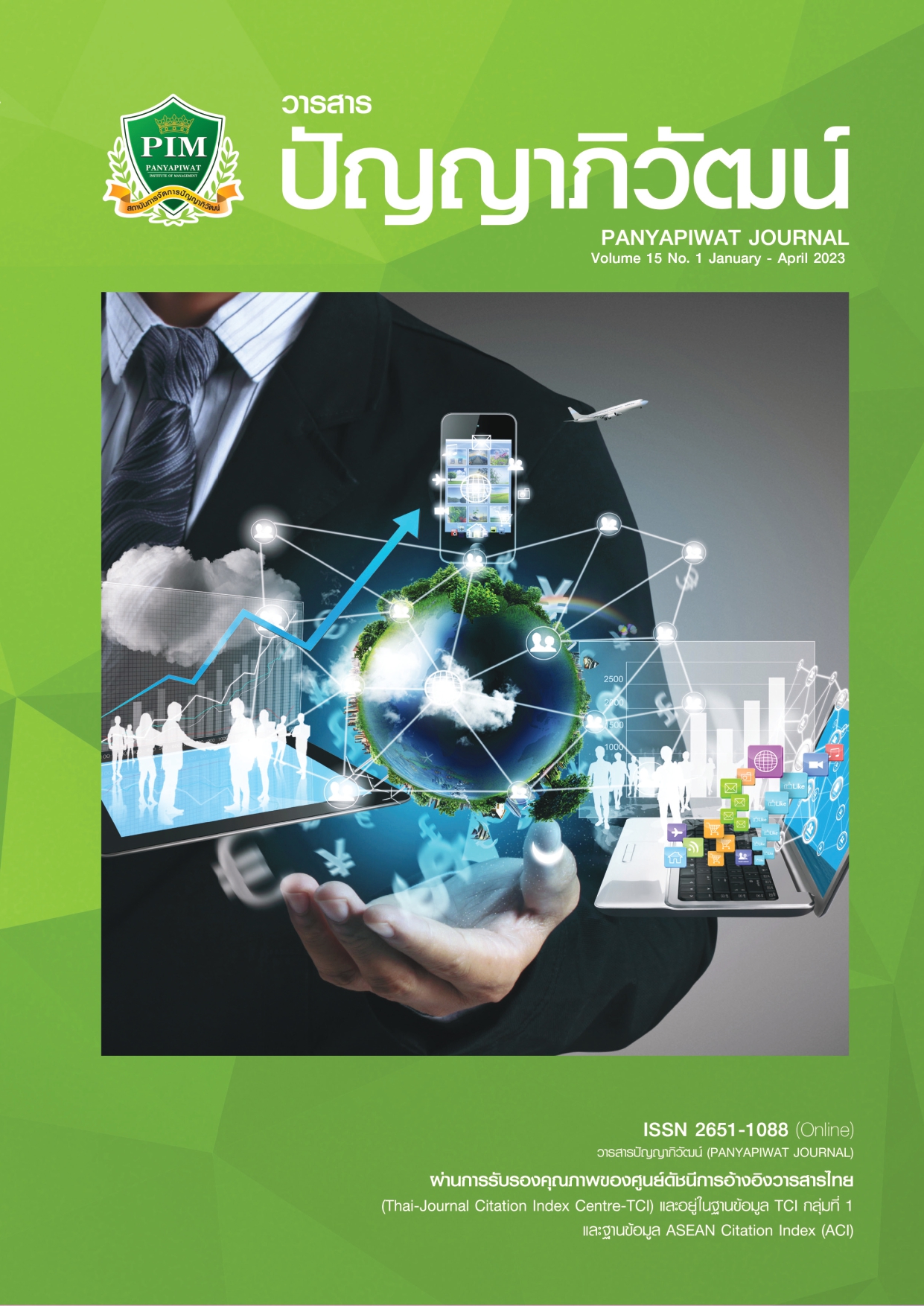การศึกษาปัจจัยที่ส่งผลต่อเวลาตอบสนองการบริการทางการแพทย์ฉุกเฉิน: กรณีศึกษา 3 เขตพื้นที่ทางตอนเหนือของกรุงเทพมหานคร
Main Article Content
บทคัดย่อ
เวลาการตอบสนองเป็นหนึ่งในเป้าหมายหลักของการบริการทางการแพทย์ฉุกเฉินทั่วโลกได้นำเวลาตอบสนองการบริการทางการแพทย์ฉุกเฉินมาเป็นหนึ่งในตัววัดประสิทธิภาพการให้บริการทางการแพทย์ฉุกเฉินการศึกษาในครั้งนี้ทำการศึกษาถึงปัจจัยที่ส่งผลต่อเวลาตอบสนองการบริการทางการแพทย์ฉุกเฉินในสามเขตพื้นที่ทางตอนเหนือของกรุงเทพมหานคร นำข้อมูลทุติยภูมิการบริการทางการแพทย์ฉุกเฉินของสถาบันการแพทย์ฉุกเฉินแห่งชาติ ข้อมูลประชากรและข้อมูลความเร็วการเดินทางบนถนนของสำนักยุทธศาตร์และประเมินผลและสำนักจราจรและขนส่งกรุงเทพมหานคร มาทำการวิเคราะห์ข้อมูลของตัวแปรอิสระโดยใช้สถิติพรรณนาและวิเคราะห์ความสัมพันธ์ระหว่างตัวแปรอิสระโดยใช้ค่าสัมประสิทธิ์สหสัมพันธ์ของเพียร์สัน (Pearson’s Product Moment Correlation) ทำวิเคราะห์ตัวแปรอิสระโดยวิธีการวิเคราะห์การถดถอยเชิงพหุคูณ (Multiple Linear Regression Analysis) วิธีนำเข้า (Enter) กำหนดตัวแปรตามคือ เวลาตอบสนองทางการแพทย์ฉุกเฉิน ผลของการวิเคราะห์ข้อมูลพบว่า ในสามเขตพื้นที่ทางตอนเหนือของกรุงเทพมหานคร ปัจจัยที่ส่งผลต่อเวลาตอบสนองทางการแพทย์ฉุกเฉินอย่างมีนัยสำคัญทางสถิติที่เหมือนกันคือ ปัจจัยด้านระยะทาง ลำดับความสามารถในการพยากรณ์ จากค่า R2 มีดังนี้ เขตคลองสามวา 62.9% เขตสายไหม 53.6% และเขตบางเขน 44.1% โดยมีความสัมพันธ์กับขนาดพื้นที่
Article Details

อนุญาตภายใต้เงื่อนไข Creative Commons Attribution-NonCommercial-NoDerivatives 4.0 International License.
“ข้าพเจ้าและผู้เขียนร่วม (ถ้ามี) ขอรับรองว่า บทความที่เสนอมานี้ยังไม่เคยได้รับการตีพิมพ์และไม่ได้อยู่ระหว่างกระบวนการพิจารณาลงตีพิมพ์ในวารสารหรือแหล่งเผยแพร่อื่นใด ข้าพเจ้าและผู้เขียนร่วมยอมรับหลักเกณฑ์การพิจารณาต้นฉบับ ทั้งยินยอมให้กองบรรณาธิการมีสิทธิ์พิจารณาและตรวจแก้ต้นฉบับได้ตามที่เห็นสมควร พร้อมนี้ขอมอบลิขสิทธิ์บทความที่ได้รับการตีพิมพ์ให้แก่สถาบันการจัดการปัญญาภิวัฒน์หากมีการฟ้องร้องเรื่องการละเมิดลิขสิทธิ์เกี่ยวกับภาพ กราฟ ข้อความส่วนใดส่วนหนึ่งและ/หรือข้อคิดเห็นที่ปรากฏในบทความข้าพเจ้าและผู้เขียนร่วมยินยอมรับผิดชอบแต่เพียงฝ่ายเดียว”
เอกสารอ้างอิง
Ai, G., Deng, Y., & Ai, W. (2018). Analysis of the factors influencing ambulance response time in Liwan District, Guangzhou. International Journal of Latest Engineering Research and Applications, 3(3), 32-40.
Best, J. W. (1977). Research in education (3rd ed.). Prentice-Hall Inc.
Chartkula, M. (2014). Factors related to death in trauma patients of advanced EMS in Thailand.
The Journal of Prapokklao Hospital Clinical Medical Education Center, 31(4), 311-326. [in Thai]
Chen, X., Liu, Z., Zhong, S., Niu, X., Huang, Y., & Zhang, L. (2019). Factors influencing the emergency medical service response time for cardiovascular disease in Guangzhou, China. Current Medical Science, 39(3), 463-471. https://doi.org/10.1007/s11596-019-2061-z
Department of Older Persons. (2022). Elderly statistics. https://www.dop.go.th/th/know/1
Jittamaii, P., Chanlawong, N., Boonyanusith, W., & Meechaiyo, S. (2019). Efficiency assessment model development of emergency medical service systems: Case study of Nakhon Ratchasima Province. Journal of Professional Routine to Research, 6, 27-36. [in Thai]
Henrik, J., Prachaksvich, L., & Anurak, A. (2014). Time is money, but how much? The monetary value of response time for Thai Ambulance Emergency Services. Value in Health, 17, 555-560. https://doi.org/10.1016/j.jval.2014.05.006
Klawwikarn, P., & Jirakajohnkool, S. (2014). Application of geographic information systems for service area analysis of Emergency Medical Service Centers in Loei Province. Thai Journal of Science and Technology, 3(3), 137-147. [in Thai]
Lam, S., Nguyen, F., Ng, Y., Lee, V., Wong, T., Fook-Chong, S., & Ong, M. (2015). Factors affecting the ambulance response times of trauma incidents in Singapore. Accident Analysis and Prevention, 82, 27-35. https://doi.org/10.1016/j.aap.2015.05.007
National Institute for Emergency Medicine. (2019). Annual report 2019. National Institute for Emergency Medicine.
National Institute for Emergency Medicine. (2022, April 27). Data warehouse. http://report.niems. go.th/niemsdwh/index.html
Phoarsa, P., & Suggaravetsiri, P. (2018). Factors related to the delay of emergency medical services for resuscitation patients on the scene in Muang District, Buriram Province. Journal of the Office of DPC 7 Khon Kaen, 25(2), 79-89. [in Thai]
Ponsen, K., Sirisamutr, T., & Wachiradilok, P. (2018). The situation of using emergency medical services at the Emergency Department of Emergency Patients in Thailand. Journal of Health Education, 41(2), 51-63. [in Thai]
Saeheng, P., Chavanasporn, K., Phanrangsee, P., Waikila, N., Santaweephol, N., Noosila, N., Saimon, T., Limjeamrangsai, T., Kwanyou, P., Mesprasart, N., & Samee, Y. (2019). The response time and the adequacy of emergency medical service team for elderly patients in Bangkok: A case study of Bangkok Emergency Medical Service Center (Erawan Center). Vajira Medical Journal: Journal of Urban Medicine, 63, 65-72. [in Thai]
Saengow, P., Papukdee, P., Worachairungreung, M., Waiyasusri, K., & Kulpanicj, N. (2020). Spatial density, Emergency Medical Services (EMS) and building utilization types of Bang Phlat District. Silpakorn University Journal, 40(6), 92-106. [in Thai]
Sripu, C., & Charerntanyarak, L. (2020). Factors related to fatalities of accident victims delivered advanced life support by receiving notice from contact 1669 in Buriram Province. KKU Journal for Public Health Research, 13(1), 41-47. [in Thai]
Strategy and Evaluation Department. (2022, April 27). Bangkok statistics. https://shorturl.asia/iygpoTraffc and Transportation
Department. (2022, April 27). Speed of travel in and out of town in Bangkok. https://offce2.bangkok.go.th/dotat/re_intersection/speed/speed.html
Yang, W., Su, Q., Huang, S., Wang, Q., Zhu, Y., & Zhou, M. (2019). Simulation modeling and optimization for ambulance allocation considering spatiotemporal stochastic demand. Journal of Management Science and Engineering, 4(4), 252-265.
Ziad, N., & Emily, A. (2016). Factors influencing the timeliness of emergency medical service response to time critical emergencies. Prehospital Emergency Care, 20(6), 783-791. https://doi.org/10.3109/10903127.2016.1164776


